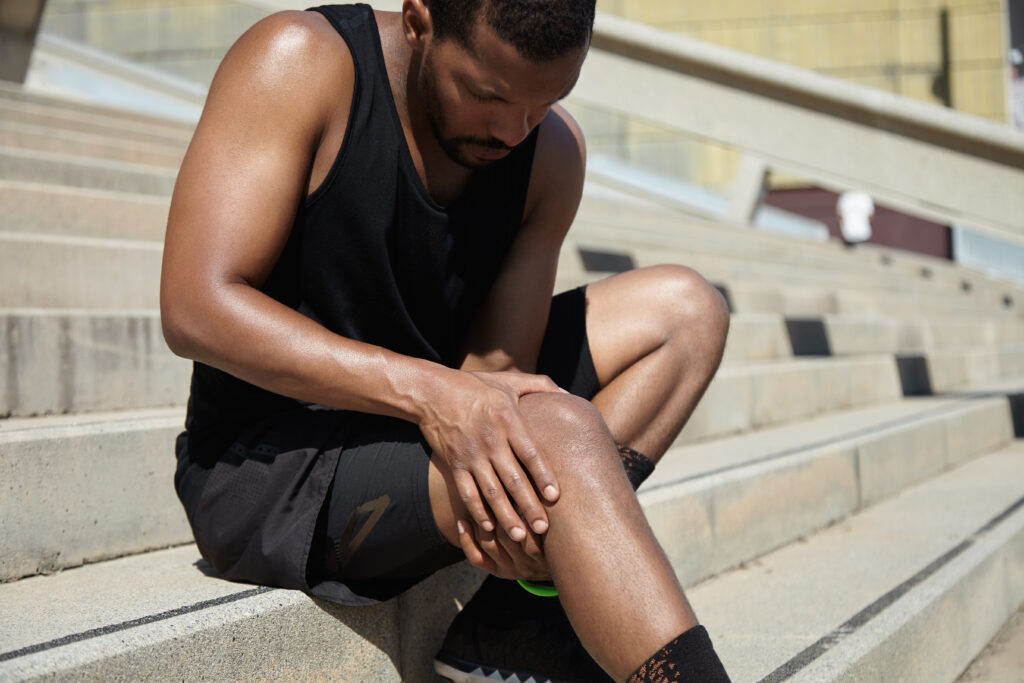When it comes to speedy athletic recovery, you might be surprised at how many factors play an essential role. It's not just about resting; nutrition, hydration, and sleep are all integral to your recovery process. You may find that incorporating specific techniques and technologies can greatly enhance your performance and overall well-being. But what if there are strategies you haven't considered yet? Exploring these elements could change how you approach your recovery and help you achieve your goals more efficiently. Let's uncover what you might be missing.
Importance of Recovery
Recovery isn't just an afterthought; it's an essential part of your training regimen. You might think that pushing your limits every day is the key to success, but without proper recovery, you're setting yourself up for burnout and injury. Your body needs time to heal and adapt after intense workouts, and neglecting this significant phase can hinder your progress.
When you train, you create tiny tears in your muscles. Recovery allows these muscles to repair, grow stronger, and ultimately enhance your performance. If you skip recovery, you're not just risking injuries; you're also limiting your strength gains and endurance over time. You'll find that your performance plateaus or even declines when you don't prioritize rest.
Listen to your body. Fatigue, soreness, and decreased motivation are all signs that you need to take a step back. Incorporate active recovery days into your schedule, where you engage in low-intensity activities like walking or yoga. This can help increase blood flow, reduce soreness, and speed up the healing process.
Additionally, sleep plays an important role in your recovery. Aim for quality sleep to allow your body to repair itself effectively. Remember, it's during sleep that growth hormones are released, aiding muscle recovery and boosting your overall performance.
Nutrition for Optimal Healing
To recover effectively, you need to focus on the essential nutrients that aid healing.
Timing your nutritional intake can make a big difference in how quickly your body bounces back.
Essential Nutrients for Recovery
When it comes to ideal healing after intense workouts or injuries, essential nutrients play an important role in your recovery journey.
First on the list are proteins, which are important for repairing muscle tissue. Incorporating lean meats, eggs, and plant-based proteins like beans and lentils can help speed up your healing process.
Next, don't overlook carbohydrates. They replenish glycogen stores, providing the energy you need to bounce back. Whole grains, fruits, and vegetables should be your go-to sources.
Healthy fats are also fundamental, as they support cell growth and help reduce inflammation. Avocados, nuts, and olive oil are excellent options.
Vitamins and minerals like vitamin C, zinc, and magnesium are critical for immune function and tissue repair. Citrus fruits, nuts, and leafy greens can provide these nutrients effectively.
Lastly, staying hydrated is key. Water helps transport nutrients and aids in the overall recovery process.
Timing Your Nutritional Intake
Timing your nutritional intake is essential for enhancing healing after workouts or injuries. When you focus on when to eat, you can improve recovery and reduce soreness. Here are some key points to reflect on:
- Post-Workout Window: Aim to consume a balanced meal or snack within 30-60 minutes after exercising. This helps replenish glycogen stores and kickstarts muscle repair.
- Protein Timing: Spread your protein intake throughout the day. Consuming 20-30 grams of protein every 3-4 hours can maximize muscle synthesis and aid in recovery.
- Hydration: Don't underestimate the power of hydration. Drink water consistently throughout the day, especially before and after workouts, to support muscle function and recovery.
- Pre-Workout Nutrition: Fuel your body with a mix of carbs and protein about 1-2 hours before your workout. This gives your body the energy it needs to perform effectively and recover better afterward.
Hydration and Performance
Hydration plays an essential role in athletic performance, impacting everything from endurance to recovery. When you stay properly hydrated, you enhance your ability to perform at your peak. Dehydration, even at mild levels, can lead to decreased endurance, increased fatigue, and impair your overall performance.
You may notice that during intense workouts, your body loses fluids through sweat, so replacing those fluids is critical.
To optimize your hydration strategy, you should start drinking water regularly throughout the day, not just during your workouts. Aim for about 17-20 ounces of water 2-3 hours before exercising and another 8 ounces about 20-30 minutes before you start.
During your workout, especially if it lasts longer than an hour, consider using sports drinks that contain electrolytes. These drinks help replenish essential minerals lost through sweat and can keep your energy levels stable.
After your workout, rehydrating is essential for recovery. Aim to drink at least 16-24 ounces of water for every pound lost during exercise. This helps restore fluid balance and supports muscle recovery.
Monitoring the color of your urine can be a helpful indicator of your hydration status—light yellow means you're on track, while darker colors indicate you need to drink more.
Sleep's Role in Recovery
Sleep greatly influences your recovery process and overall athletic performance. When you prioritize quality sleep, you're not just resting; you're actively optimizing your body's ability to heal and strengthen.
Here are four key ways sleep impacts your recovery:
- Muscle Repair: During deep sleep, your body releases growth hormones essential for muscle repair and growth, helping you bounce back stronger after intense training.
- Inflammation Reduction: Adequate sleep helps regulate inflammation in your body. By minimizing inflammation, you can reduce soreness and fatigue, allowing you to train harder and recover faster.
- Cognitive Function: A well-rested mind is more focused and sharper. Good sleep enhances your decision-making abilities and reaction times, fundamental for peak performance during competitions.
- Hormonal Balance: Sleep regulates hormones such as cortisol and testosterone, which play critical roles in recovery, mood, and energy levels. Disrupted sleep can lead to hormonal imbalances that hinder your performance.
To maximize your recovery, aim for 7-9 hours of quality sleep each night. Establish a bedtime routine, limit screen time before bed, and create a comfortable sleep environment.
Remember, your body needs time to recover from the physical demands you place on it. By prioritizing sleep, you're not just giving yourself a break; you're actively investing in your athletic performance.
Active Recovery Techniques
Active recovery techniques are essential for athletes looking to enhance their recovery and maintain peak performance levels. These methods help you engage in low-intensity activities that promote blood flow and reduce muscle soreness without putting undue stress on your body. Incorporating active recovery into your routine can make a notable difference in how quickly you bounce back after intense training or competition.
One of the simplest active recovery techniques is light aerobic exercise. Activities like walking, cycling, or swimming at a gentle pace can help flush out metabolic waste products while keeping your muscles engaged. Aim for 20 to 30 minutes of this low-impact exercise to reap the benefits.
Another effective method is incorporating dynamic movements or recreational activities you enjoy. Try playing a casual game of basketball, going for a hike, or practicing yoga. These activities not only aid recovery but also keep your mind engaged and motivated.
Additionally, consider incorporating foam rolling or self-myofascial release into your routine. Spending a few minutes on a foam roller can help alleviate tightness and improve circulation. This technique can complement your active recovery sessions by targeting specific muscle groups that may feel sore.
Lastly, don't underestimate the importance of hydration and nutrition during your active recovery days. Staying well-hydrated and refueling your body with nutritious foods can notably enhance your recovery process.
Stretching and Mobility Work
Incorporating stretching and mobility work into your routine can further enhance your recovery process and improve your overall performance. It's not just about feeling good; these practices help maintain flexibility, reduce injury risk, and enhance your range of motion.
By committing to a regular stretching and mobility regimen, you can reap significant benefits. Here are four key reasons to include it in your routine:
- Improved Flexibility: Regular stretching helps elongate muscles, allowing for better movement patterns and improved athletic performance.
- Reduced Muscle Tension: Mobility work can relieve tightness and tension in your muscles, promoting relaxation and aiding in faster recovery.
- Enhanced Blood Flow: Stretching encourages circulation, which helps deliver essential nutrients to your muscles and speeds up the healing process.
- Injury Prevention: By increasing your range of motion and flexibility, you lower your risk of injuries during training and competition.
To get started, set aside time after your workouts for a dedicated stretching session. Focus on major muscle groups, holding each stretch for at least 20-30 seconds.
Incorporate dynamic mobility exercises before your workouts to warm up your joints and prepare your body for movement. Remember, consistency is key. The more you integrate stretching and mobility work into your routine, the more you'll notice improvements in your recovery and overall athletic performance.
Innovative Recovery Technologies
In the ever-evolving world of sports and fitness, innovative recovery technologies are transforming how athletes restore their bodies after intense training sessions.
You've probably heard of techniques like cryotherapy, which involves exposing your body to extremely cold temperatures to reduce inflammation and speed up recovery. This method can help alleviate soreness and improve muscle recovery, making it a favorite among elite athletes.
Another game-changer is percussion therapy. Devices like massage guns deliver rapid bursts of pressure, targeting sore muscles and breaking up tension. Using one of these tools can enhance blood flow and promote quicker healing, allowing you to bounce back faster for your next workout.
Compression therapy is also gaining traction. By using specialized garments that apply pressure to your limbs, you can enhance circulation and reduce swelling. Many athletes swear by this method, especially after grueling competitions.
Infrared therapy is another exciting option, using heat to penetrate deep into muscle tissue, improving circulation and accelerating recovery.
Don't forget about electrical stimulation devices. These gadgets send gentle electrical impulses to your muscles, helping to relieve pain and promote relaxation. They can be particularly beneficial during those tough recovery days.
Incorporating these innovative technologies into your routine can considerably enhance your recovery process.
Mental Recovery Strategies
To enhance your athletic recovery, you can use mental strategies like visualization and mindfulness.
These techniques help you focus, reduce stress, and improve your overall performance.
Visualization Techniques
During moments of intense training or competition, athletes often overlook the power of visualization techniques as an essential part of their mental recovery strategies.
These techniques can greatly enhance your performance and expedite recovery by focusing your mind on success and relaxation. Here are some key visualization practices to incorporate into your routine:
- Visualize Success: Picture yourself executing your skills flawlessly during competition. This mental rehearsal can boost your confidence and prepare you for real-life scenarios.
- Focus on Recovery: Imagine your body healing and rejuvenating after intense workouts. Visualizing muscle repair can make the recovery process feel more tangible and effective.
- Create a Calm Space: Picture a serene environment that promotes relaxation. This mental imagery can help reduce stress and anxiety, allowing your body to recover more efficiently.
- Set Goals: Visualize your long-term and short-term goals, breaking them down into achievable steps. This clarity can motivate you to stay dedicated to your recovery process.
Mindfulness Practices
Mindfulness practices serve as powerful tools for mental recovery, helping athletes cultivate a present-focused mindset. By incorporating techniques like meditation, breathing exercises, and body scans into your routine, you can enhance your mental resilience and emotional well-being.
Start by dedicating just a few minutes each day to sit quietly and focus on your breath. Feel the air moving in and out, anchoring yourself in the moment. This simple act can reduce anxiety and improve your focus, allowing you to perform at your best during training and competitions.
In addition, try engaging in mindful movement, such as yoga or tai chi. These practices not only enhance physical flexibility and strength but also deepen your connection between body and mind.
When you encounter setbacks or fatigue, remember to practice self-compassion. Acknowledge your feelings without judgment, and remind yourself that recovery is a journey.
Building a Personalized Recovery Plan
Creating a personalized recovery plan is essential for maximizing your athletic performance and preventing injuries. Each athlete is different, and your recovery strategy should reflect your unique needs, goals, and circumstances.
Here are four key elements to contemplate when building your plan:
- Assess Your Current State: Start by evaluating your fitness level, any existing injuries, and how your body responds to different types of workouts. This assessment will help you identify areas that need special attention.
- Incorporate Varied Recovery Techniques: Use a mix of recovery methods like active recovery, stretching, foam rolling, and massages. Diversifying your techniques can prevent burnout and keep your body in peak condition.
- Set Clear Goals: Define what you want to achieve with your recovery plan. Whether it's reducing soreness, improving flexibility, or enhancing overall performance, having specific goals will keep you focused and motivated.
- Monitor Progress and Adjust: Track your recovery progress regularly. If something isn't working or you're not feeling your best, don't hesitate to modify your plan. Flexibility is key to finding what truly works for you.
Conclusion
Incorporating these recovery strategies into your routine is essential for maximizing your athletic performance. By prioritizing nutrition, hydration, and quality sleep, along with active recovery techniques and innovative therapies, you'll set yourself up for success. Don't forget the mental aspect of recovery, too—it's just as important. By building a personalized recovery plan, you'll not only speed up your recovery but also enhance your overall performance. Start implementing these secrets today and watch your athletic potential unfold!



